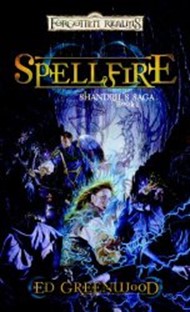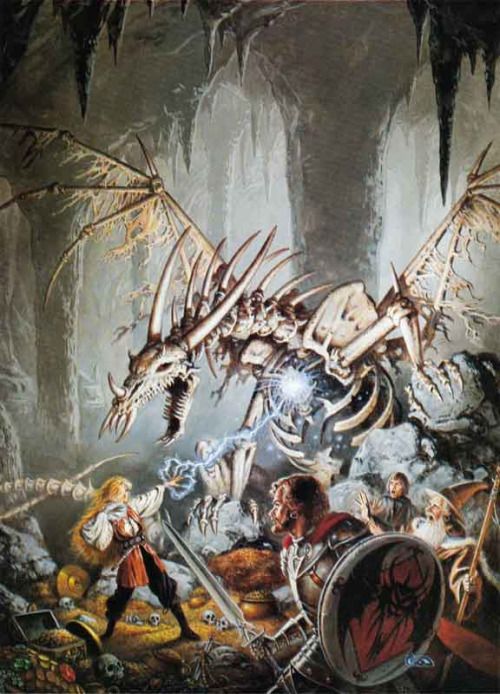 The fourth novel set in the Forgotten Realms, Spellfire, was released in July 1988. It was the first novel of the creator of the Realms, Ed Greenwood, and it would prove to be his only novel for six years, as he was kept rather busy writing gaming material for the Realms. (Since 1994, he’s published quite a few more books…)
The fourth novel set in the Forgotten Realms, Spellfire, was released in July 1988. It was the first novel of the creator of the Realms, Ed Greenwood, and it would prove to be his only novel for six years, as he was kept rather busy writing gaming material for the Realms. (Since 1994, he’s published quite a few more books…)
Spellfire exists in two forms: the original release, and a revised “expanded” release (which, oddly, is shorter than the original one!) I read the original book when it was released many, many times; I have only just read the revised (2002) edition. It’s a book of immense personal significance to me; the book that really made me fall in love with the Realms.
It’s not without its problems, however.
The book tells the story of Shandril Shessair, a young girl raised in an inn in Highmoon who craves adventure. She runs away from her adoptive father with a band of adventurers to discover it. Unfortunately, while the adventures she finds are certainly exciting, they’re definitely not safe: her adventuring company are slain, she’s chased through several teleportation devices to first Myth Drannor and then the lair of a dracolich, offered as a sacrifice, and is only saved by the intervention of some truly experienced adventurers: The Knights of Myth Drannor and their friend, Elminster, Sage of Shadowdale.
Along the way she falls in love with a young magic-user, Narm, and discovers she has the rare talent of creating and manipulating spellfire – the raw stuff of magic – which she uses to destroy two dracoliches and a large number of other enemies who seek her to control her or kill her. Basically, every power in the area wants her: with the Zhentarim and the Cult of the Dragon being the two major organisations that keep sending men and women (and dragons) to get her. Eventually, with most of them dead and now treating her with caution, she’s able to escape with Narm to the North of the Savage Frontier, far away from her original home, where she hopes she’ll be able to live in peace.
The first part of the book is glorious. In the second half, the constant attacks begin to get wearisome. The picture it paints of the Realms is an unsettling one. One of the criticisms of the Realms by gamers is that there are too many powerful characters in it to allow the heroism of new characters; this is the novel that cleaves the closest to that description. Although the previous three Realms novels had the gods meddling in the affairs of mankind, their actual human servants were typically not too powerful. This novel has many of the most powerful wizards in the Realms dropping in for a visit, and the world it paints is terrifying. There is another tier of power on display here: consider the difference between the threats faced by Daredevil and the threats faced by Thor. That’s the disparity we’re talking about. Can a setting maintain that? Certainly it can – comic book universes like Marvel and DC have been doing it for decades – but we tend not to think of the Realms on those terms.
 Despite the problems in the development of the plot (the problem being that it doesn’t develop enough, with not enough time for Shandril to properly develop as a character), the book is full of entertaining characters and brilliant world-building. The Knights of Myth Drannor were drawn from the player characters used by Ed Greenwood’s friends in his D&D games. There’s an astonishing amount of detail to their history, only some of which we see in the book. Given that Greenwood had been playing D&D since 1975, and running games since 1978, there had been a lot of adventuring in the Realms by the time Spellfire was written. (Ed Greenwood notes that after 20 years of play, the highest level of the Knights had only reached 9th level! There are major differences between the literary Realms and that of Greenwood’s home campaign!) The Knights, at one point, describe themselves as still children – still with that love of play and adventure – and this is very obvious in their banter with each other.
Despite the problems in the development of the plot (the problem being that it doesn’t develop enough, with not enough time for Shandril to properly develop as a character), the book is full of entertaining characters and brilliant world-building. The Knights of Myth Drannor were drawn from the player characters used by Ed Greenwood’s friends in his D&D games. There’s an astonishing amount of detail to their history, only some of which we see in the book. Given that Greenwood had been playing D&D since 1975, and running games since 1978, there had been a lot of adventuring in the Realms by the time Spellfire was written. (Ed Greenwood notes that after 20 years of play, the highest level of the Knights had only reached 9th level! There are major differences between the literary Realms and that of Greenwood’s home campaign!) The Knights, at one point, describe themselves as still children – still with that love of play and adventure – and this is very obvious in their banter with each other.
Not all of the Knights get equal time – Torm the thief definitely seems to dominate the pages when he’s around – but you do get to meet all of them, discover their distinct personalities, and understand something of their lives.
To a large extent, the plot of Spellfire is there only to allow the characters to interact. Ed Greenwood has a remarkable gift for characterisation, and Spellfire investigates what it means to be so powerful, as seen from many different viewpoints. The theme of loneliness vs love and friendship is very strong in the book, and some of its most affecting moments come as Elminster comforts a dying sorceress who once was his promising apprentice before she turned to evil.
It was Ed Greenwood’s original intention to have Elminster as mostly a background character in the Realms, but the clamour of the readers’ and his editors’ desire for more Elminster derailed that plan. Ed, if you’re ever looking to see where that plan went wrong, go and reread Spellfire: Elminster is brilliant in it, human in all the best of ways and a character I just want to spend more time with. His powers are immaterial when you consider his interactions with those around him, and it’s in them that is realised one of the best characters of the Realms. Against the glory of Elminster, how can the (relatively) undeveloped Narm and Shandril compare?
Spellfire, for all its faults, is a tremendously important book. It introduces the reader to the heart of the Realms, along with several significant characters and factions that are still relevant today. It’s filled with fascinating detail, much of which I haven’t even touched upon in this review. I don’t reread books lightly. I certainly don’t reread them ten times without there being merit to them. Spellfire deserved those rereads, and it deserves your attention.
